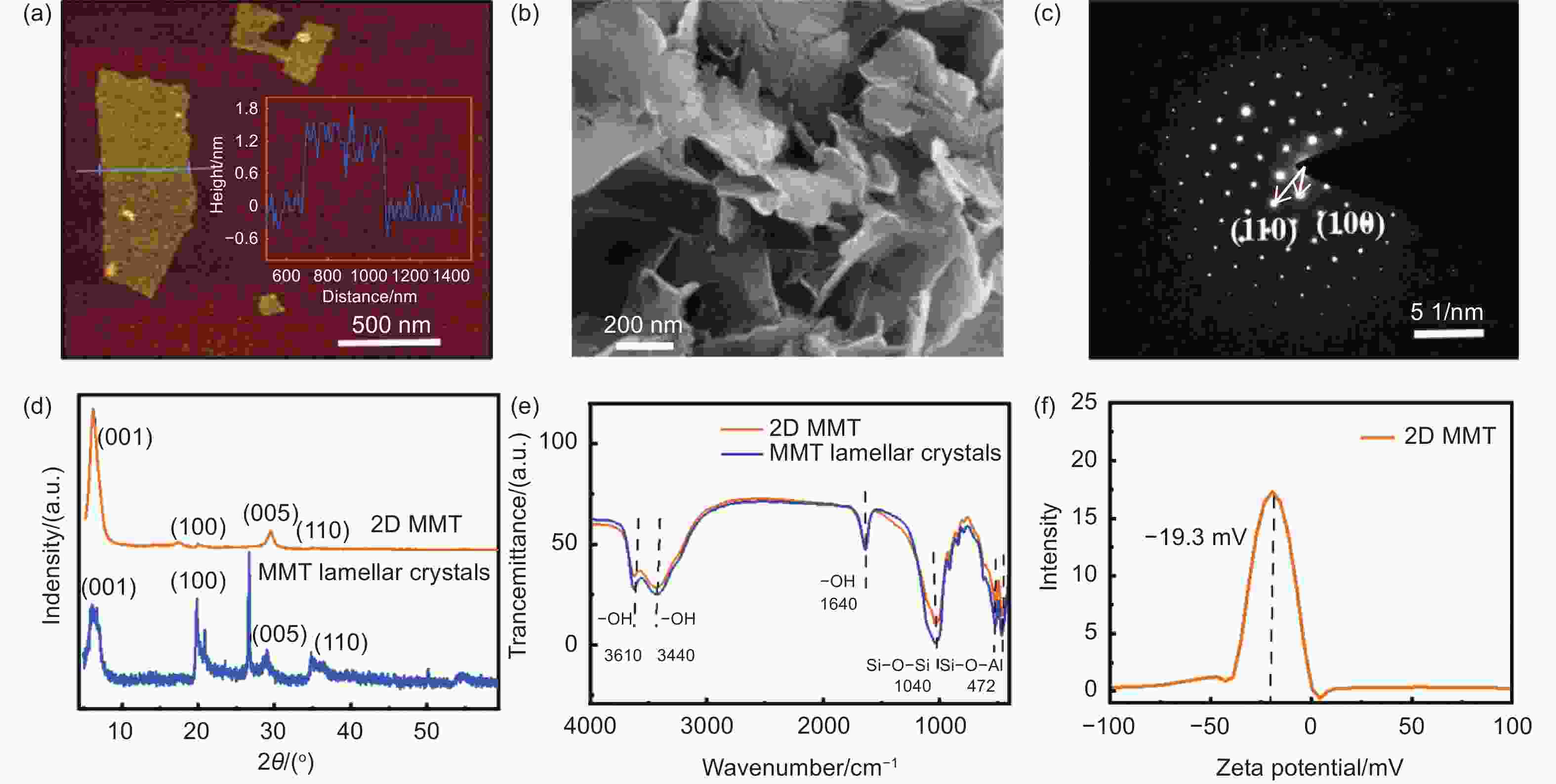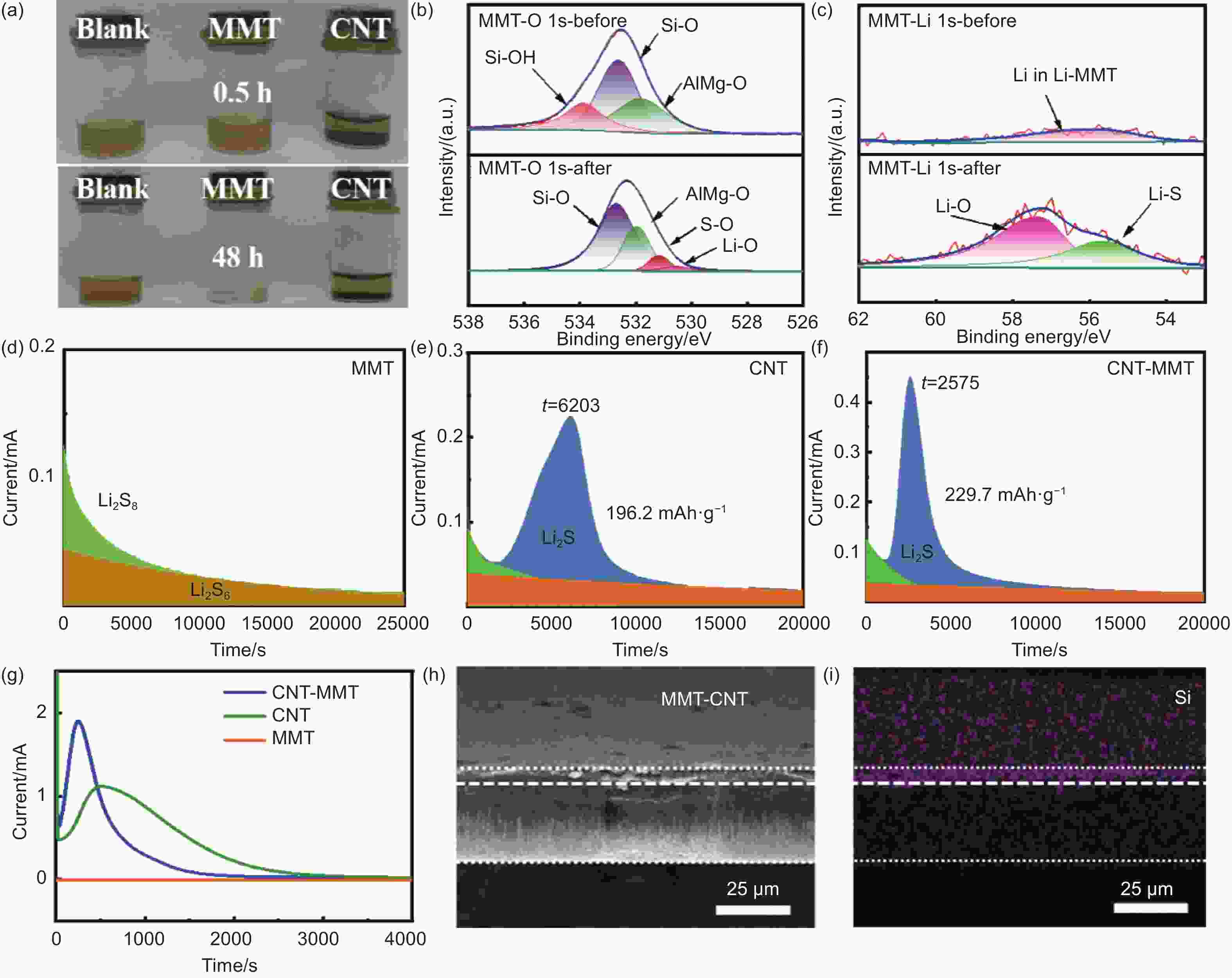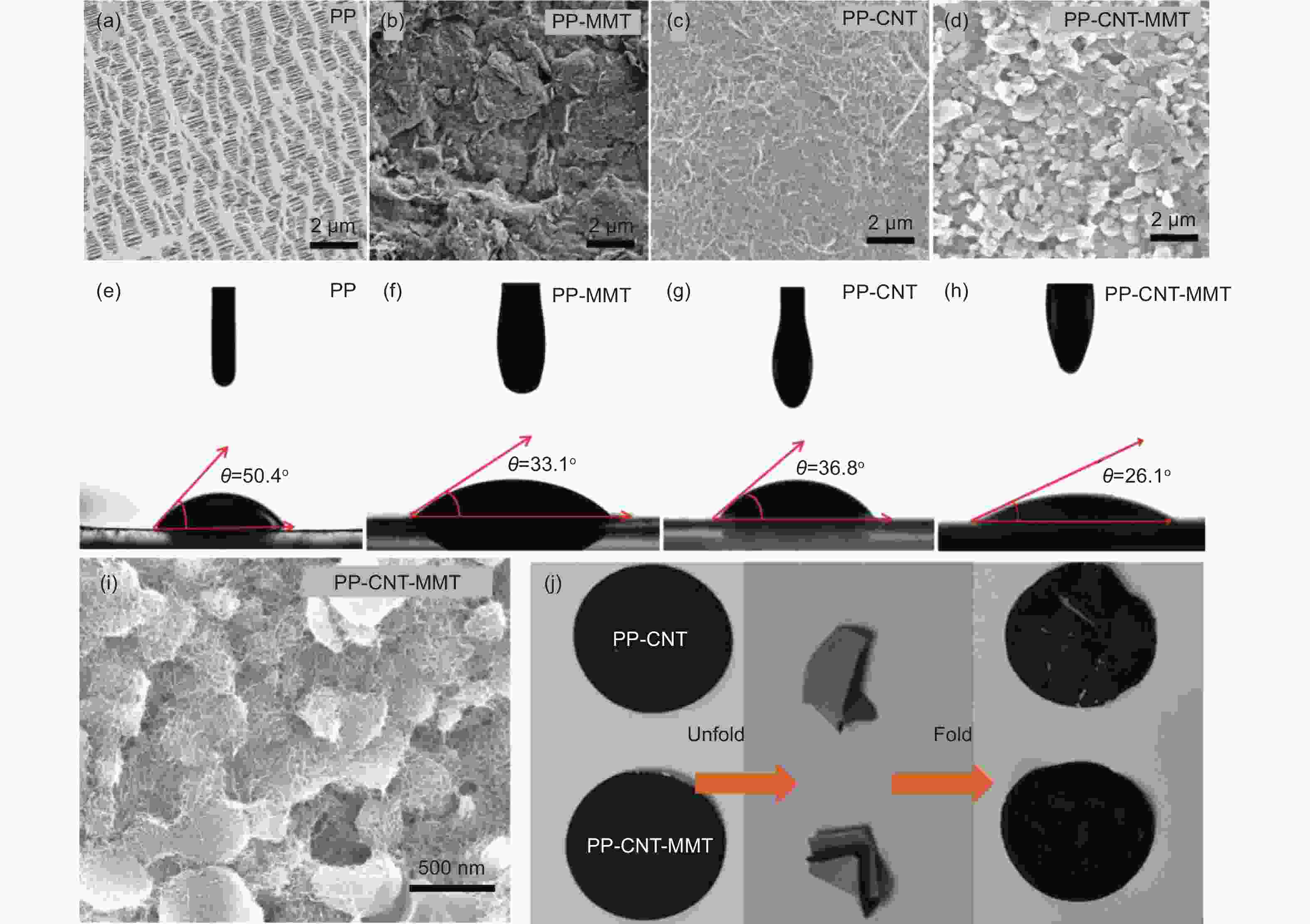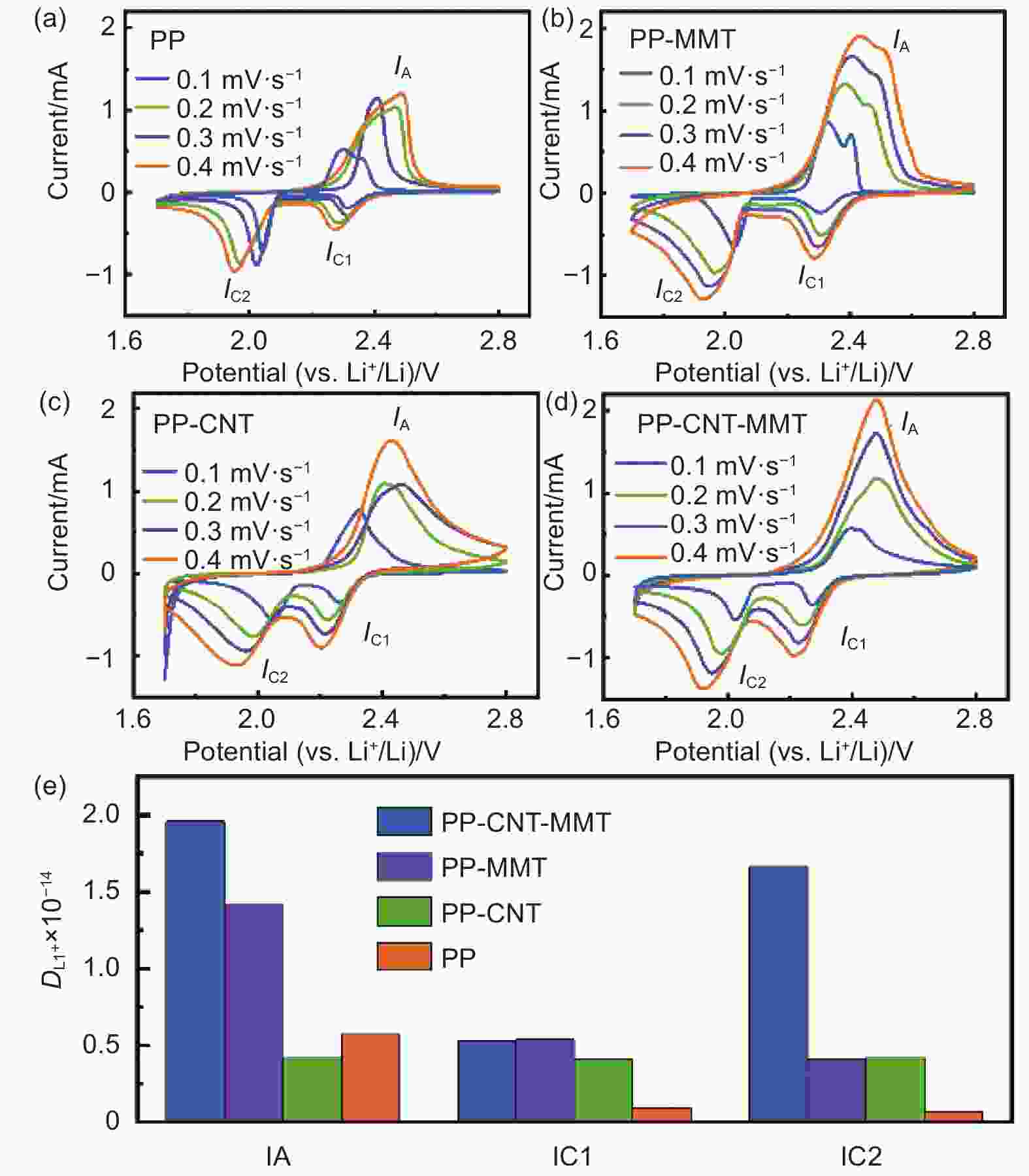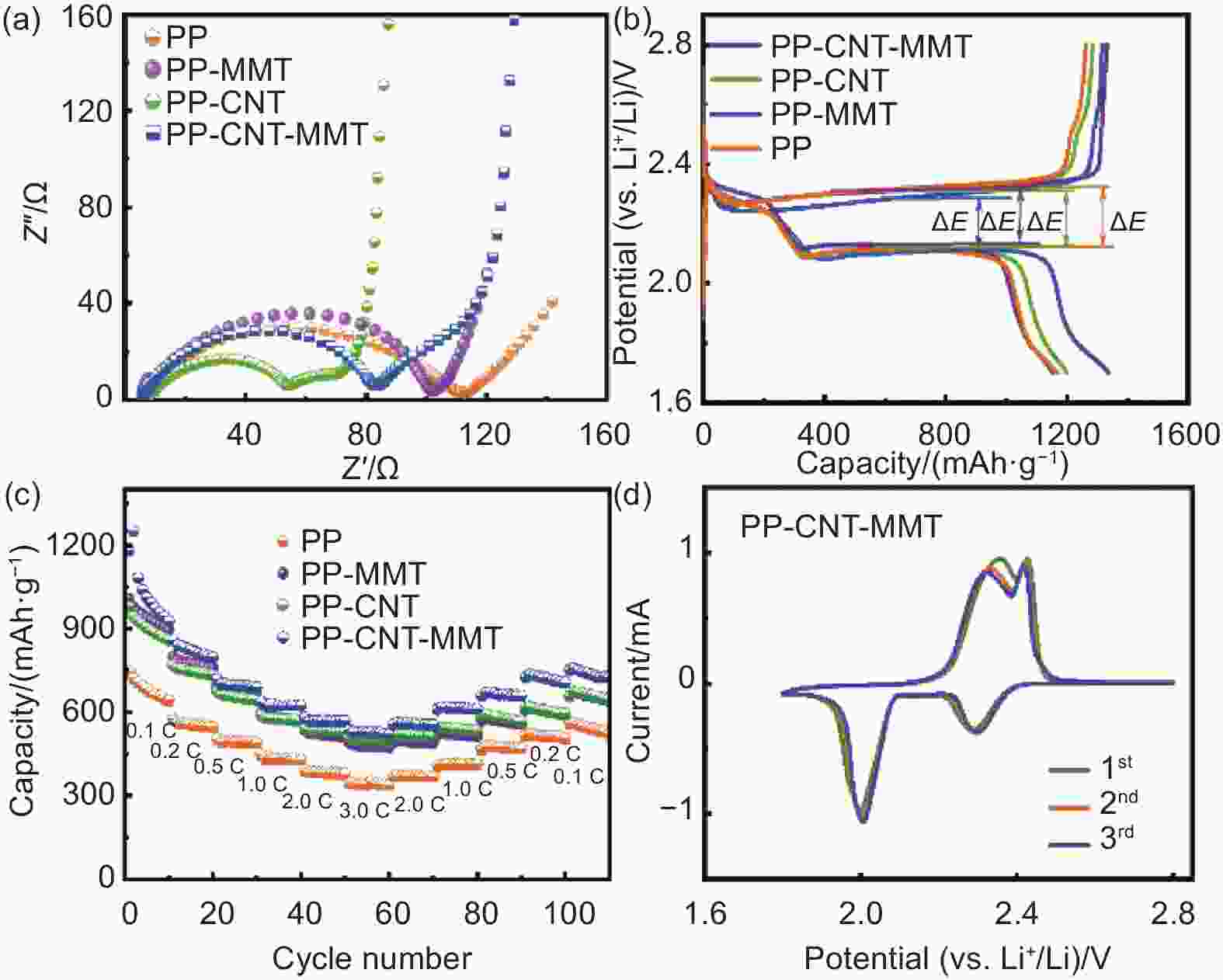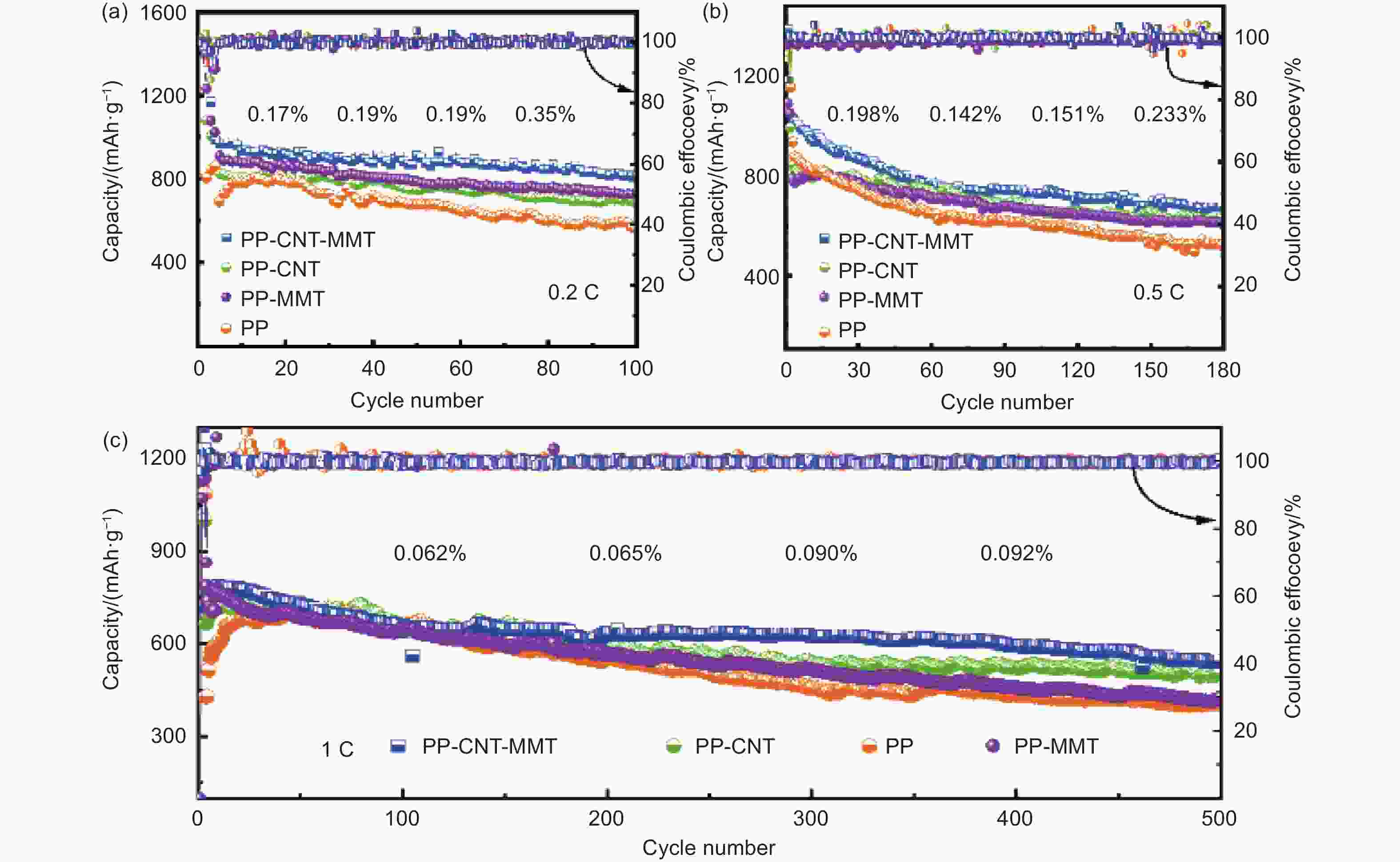A 2D montmorillonite-carbon nanotube interconnected porous network that prevents polysulfide shuttling
-
摘要: 将一维碳纳米管(CNT)和二维蒙脱土(MMT)纳米片复合并用于修饰商用聚丙烯(PP)隔膜。得益于碳纳米管的高电子导电性,以及MMT对多硫化物(LiPS)的强吸附能力和低的锂离子传输势垒,所得的交联多孔CNT-MMT复合阻挡层具有优异的结构稳定性和高的锂离子传输能力,表现出抑制LiPS穿梭的性能,因此实现了高硫利用率。结果表明,该复合阻挡层修饰的PP隔膜有效提升了锂硫电池的锂离子扩散系数、放电比容量和循环稳定性。所组装锂硫电池的0.1 C初始放电比容量为1373 mAh g−1,且具有良好的循环稳定性,在1 C下经500次循环后其每圈容量衰减率仅为0.062%。Abstract: A commercial polypropylene (PP) separator was modified by a one-dimensional carbon nanotube (CNT) and two-dimensional montmorillonite (MMT) hybrid material (CNT-MMT). Because of the high electron conductivity of the CNTs, and the strong polysulfide (LiPS) adsorption ability and easy lithium ion transport through MMT, the interconnected porous CNT-MMT interlayer with excellent structural integrity strongly suppresses LiPS shuttling while maintaining high lithium-ion transport, producing a high utilization of the active sulfur. Lithium-sulfur batteries assembled with this interlayer have a high lithium-ion diffusion coefficient, a high discharge capacity and stable cycling performance. They had an initial specific capacity of 1373 mAh g−1 at 0.1 C, and a stable cycling performance with a low decay rate of 0.062% per cycle at 1 C after 500 cycles.
-
Figure 1. Characterization of 2D MMT. (a) AFM image and the corresponding height profile (inset), (b) SEM image and (c) SAED pattern of the MMT nanosheets. (d) XRD patterns and (e) FTIR spectra of the 2D MMT nanosheets and MMT lamellar crystals. (f) Zeta potential plot of the aqueous suspensions containing 2D MMT
Figure 2. (a) Photos of different samples soaked in a Li2S6/DOL/DME solution with different time, (b) O 1s spectra and (c) Li 1s XPS spectra of MMT before and after absorbing Li2S6. (d-f) Nucleation of the Li2S measurements of the cells based on various electrodes. (g) Potentiostatic charge profiles of the cells with MMT, CNT and CNT-MMT electrode. (h) Cross-section SEM image and (i) EDS mapping of the MMT-CNT
-
[1] Armand M, Tarascon J M. Building better batteries[J]. Nature,2008,451(7179):652-657. doi: 10.1038/451652a [2] Tarascon J M, Armand M. Issues and challenges facing rechargeable lithium batteries[J]. Nature,2001,414(6861):359-367. doi: 10.1038/35104644 [3] Xu K. A long journey of lithium: From the big bang to our smartphones[J]. Energy & Environmental Materials,2019,2(4):229-233. [4] Ji X, Lee K T, Nazar L F. A highly ordered nanostructured carbon-sulphur cathode for lithium-sulphur batteries[J]. Nature Materials,2009,8(6):500-506. doi: 10.1038/nmat2460 [5] Song Y, Long X, Luo Z, et al. Solid carbon spheres with interconnected open pore channels enabling high-efficient polysulfide conversion for high-rate lithium-sulfur batteries[J]. ACS Applied Materials & Interfaces,2022,14(28):32183-32195. [6] Li L B, Shan Y H. The use of graphene and its composites to suppress the shuttle effect in lithium-sulfur batteries[J]. New Carbon Materials,2021,36(2):336-349. doi: 10.1016/S1872-5805(21)60023-9 [7] Liang X, Wen Z, Liu Y U, et al. Improved cycling performances of lithium sulfur batteries with LiNO3-modified electrolyte[J]. Journal of Power Sources,2011,196(22):9839-9843. doi: 10.1016/j.jpowsour.2011.08.027 [8] Moon S, Jung Y H, Jung W K, et al. Encapsulated monoclinic sulfur for stable cycling of Li-S rechargeable batteries[J]. Advanced Materials,2013,25(45):6547-6553. doi: 10.1002/adma.201303166 [9] Dong Z, Zhang J, Zhao X, et al. Sulfur@hollow polypyrrole sphere nanocomposites for rechargeable Li-S batteries[J]. Rsc Advances,2013,3(47):24914-24917. doi: 10.1039/c3ra45683h [10] Bing D, Shen L, Xu G, et al. Encapsulating sulfur into mesoporous TiO2 host as a high performance cathode for lithium-sulfur battery[J]. Electrochimica Acta,2013,107(10):78-84. [11] Dong Q, Shen R, Li C, et al. Construction of soft base tongs on separator to grasp polysulfides from shuttling in lithium-sulfur batteries[J]. Small,2018,14(52):e1804277. doi: 10.1002/smll.201804277 [12] Du Z, Guo C, Wang L, et al. Atom-thick interlayer made of CVD-grown graphene film on separator for advanced lithium-sulfur batteries[J]. ACS Appl Mater Interfaces,2017,9(50):43696-43703. doi: 10.1021/acsami.7b14195 [13] Xiao Z, Yang Z, Wang L, et al. A lightweight TiO2/graphene interlayer, applied as a highly effective polysulfide absorbent for fast, long-life lithium-sulfur batteries[J]. Advanced Materials,2015,27(18):2891-2898. doi: 10.1002/adma.201405637 [14] Yao H, Yan K, Li W, et al. Improved lithium-sulfur batteries with a conductive coating on the separator to prevent the accumulation of inactive s-related species at the cathode-separator interface[J]. Energy Environmental Science,2014,7(10):3381-3390. doi: 10.1039/C4EE01377H [15] Long X, Zhu S K, Song Y, et al. Engineering the interface between separators and cathodes to suppress polysulfide shuttling in lithium-sulfur batteries[J]. New Carbon Materials,2022,37(3):527-543. doi: 10.1016/S1872-5805(22)60614-0 [16] Yin F, Jin Q, Zhang X T, et al. Design of a 3D CNT/Ti3T2Tx aerogel-modified separator for Li–S batteries to eliminate both the shuttle effect and slow redox kinetics of polysulfides[J]. New Carbon Materials,2022,37(4):724-733. doi: 10.1016/S1872-5805(21)60085-9 [17] Shao Z T, Wu L L, Yang Y, et al. Carbon nanotube-supported MoSe2 nanoflakes as an interlayer for lithium-sulfur batteries[J]. New Carbon Materials,2021,36(1):219-226. doi: 10.1016/S1872-5805(21)60015-X [18] Sun Z, Guo Y, Li B, et al. ZnO/carbon nanotube/reduced graphene oxide composite film as an effective interlayer for lithium/sulfur batteries[J]. Solid State Sciences,2019,95:105924. doi: 10.1016/j.solidstatesciences.2019.06.013 [19] Yuan H, Peng H J, Li B Q, et al. Conductive and catalytic triple-phase interfaces enabling uniform nucleation in high-rate lithium-sulfur batteries[J]. Advanced Energy Materials,2019,9(1):1802768. doi: 10.1002/aenm.201802768 [20] Kaisar N, Abbas S A, Ding J, et al. A lithium passivated MoO3 nanobelt decorated polypropylene separator for fast-charging long-life Li-S batteries[J]. Nanoscale,2019,11(6):2892-2900. doi: 10.1039/C8NR08262F [21] Wu X, Fan L, Qiu Y, et al. Ion-selective prussian-blue-modified celgard separator for high-performance lithium-sulfur battery[J]. ChemSusChem,2018,11(18):3345-3351. doi: 10.1002/cssc.201800871 [22] Kehal M, Reinert L, Maurin D, et al. The trapping of B from water by exfoliated and functionalized vermiculite[J]. Clays and Clay Minerals,2008,56(4):453-460. doi: 10.1346/CCMN.2008.0560406 [23] Gamba M, Kovář P, Pospíšil M, et al. Insight into thiabendazole interaction with montmorillonite and organically modified montmorillonites[J]. Applied Clay Science,2017,137:59-68. doi: 10.1016/j.clay.2016.12.001 [24] Pei F, Lin L, Fu A, et al. A two-dimensional porous carbon-modified separator for high-energy-density Li-S batteries[J]. Joule,2018,2(2):323-336. doi: 10.1016/j.joule.2017.12.003 [25] Liao Y, Yuan L, Liu X, et al. Low-cost fumed silicon dioxide uniform Li+ flux for lean-electrolyte and anode-free Li/S battery[J]. Energy Storage Materials,2022,48:366-374. doi: 10.1016/j.ensm.2022.03.035 [26] Ghadami A, Taheri Qazvini N, Nikfarjam N. Ionic conductivity in gelatin-based hybrid solid electrolytes: The non-trivial role of nanoclay[J]. Journal of Materials Science & Technology,2014,30(11):1096-1102. [27] Long X, Luo Z H, Zhou W H, et al. Two-dimensional montmorillonite-based heterostructure for high-rate and long-life lithium-sulfur batteries[J]. Energy Storage Materials,2022,52:120-129. doi: 10.1016/j.ensm.2022.07.041 [28] Li W Y, Luo Z H, Long X, et al. Cation vacancy-boosted lewis acid-base interactions in a polymer electrolyte for high-performance lithium metal batteries[J]. ACS Applied Materials & Interfaces,2021,13(43):51107-51116. doi: 10.1021/acsami.1c17002 [29] Peng X, Wang T, Liu B, et al. A solvent molecule reconstruction strategy enabling a high-voltage ether-based electrolyte[J]. Energy & Environmental Science,2022,15(12):5350-5361. [30] Zhang T, Wang W, Zhao Y, et al. Removal of heavy metals and dyes by clay-based adsorbents: From natural clays to 1D and 2D nano-composites[J]. Chemical Engineering Journal,2021,420:127574. doi: 10.1016/j.cej.2020.127574 [31] Liu M L, Huang M, Tian L Y, et al. Two-dimensional nanochannel arrays based on flexible montmorillonite membranes[J]. ACS Applied Materials & Interfaces,2018,10(51):44915-44923. [32] Lan Y, Liu Y, Li J, et al. Natural clay-based materials for energy storage and conversion applications[J]. Advanced Science,2021,8(11):e2004036. doi: 10.1002/advs.202004036 [33] SHAO Jiao-jing, ZHENG De-yi, Li Zheng-jie, et al. Top-down fabrication of two-dimensional nanomaterials: Controllable liquid phase exfoliation[J]. New Carbon Materials,2016,31(02):97-114. [34] Chen W, Lei T, Lv W, et al. Atomic interlamellar ion path in high sulfur content lithium-montmorillonite host enables high-rate and stable lithium-sulfur battery [J]. Advanced Materials. 2018, e1804084 [35] Wang W, Yang Y, Luo H, et al. Design of advanced separators for high performance Li-S batteries using natural minerals with 1D to 3D microstructures[J]. Journal of Colloid and Interface Science,2022,614:593-602. doi: 10.1016/j.jcis.2022.01.148 -





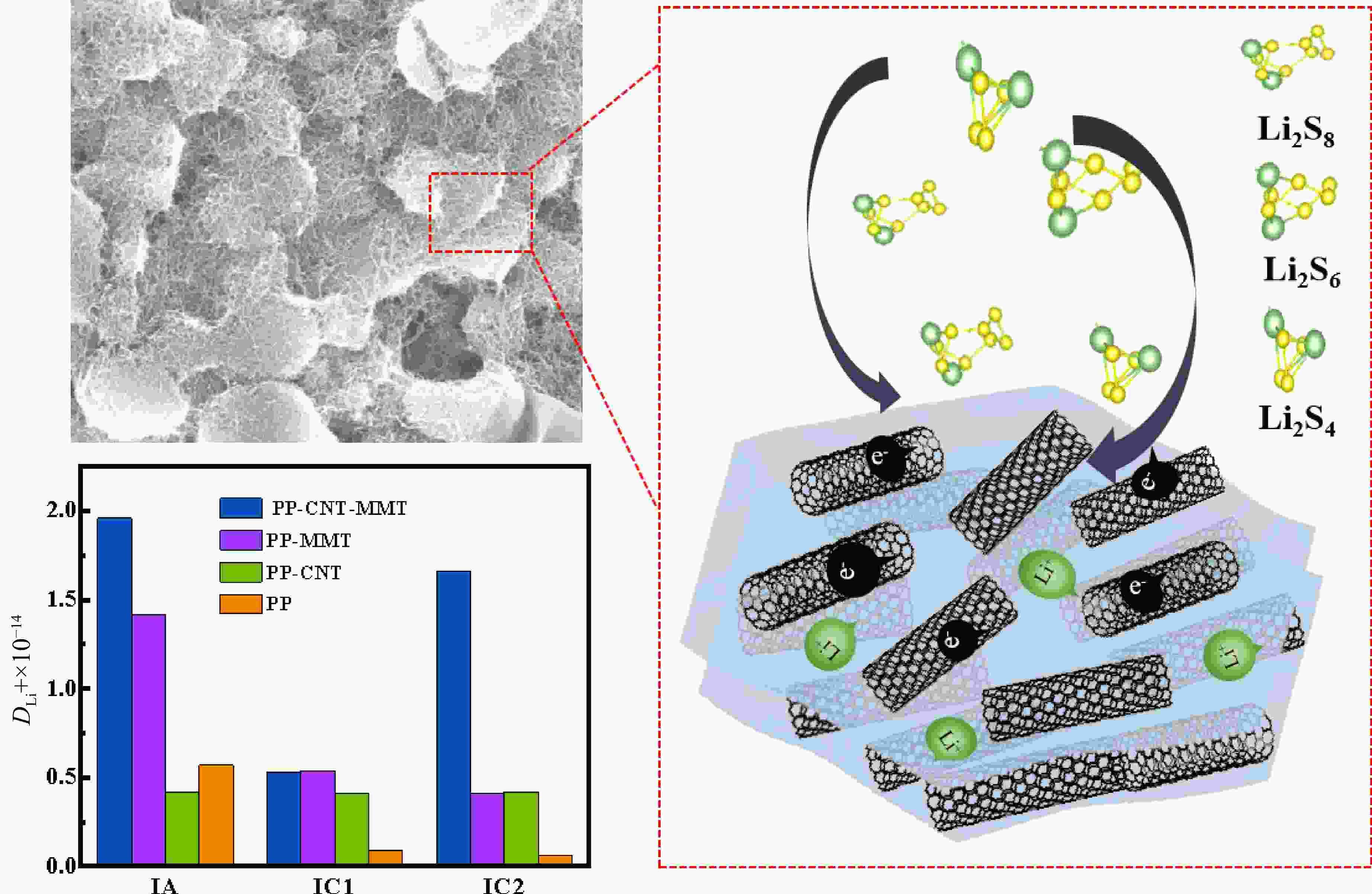
 下载:
下载:
